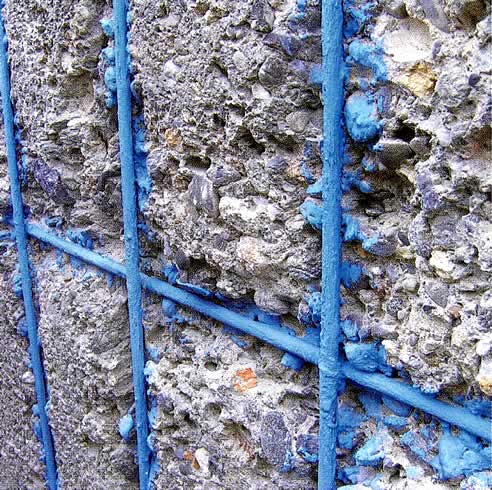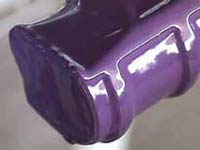Corrosion of reinforcing steel is implicated in a majority of deteriorating concrete structures. In addition to HPC described previously, there are several recently developed technologies that are being pursued to address this problem, namely the use of corrosion-inhibiting admixtures, epoxycoated steel reinforcement, cathodic protection, and application of protective coatings on the concrete surface.
Corrosion-inhibiting admixtures:
Berke and Weil presented a comprehensive review of corrosion-inhibiting admixtures in concrete. 2 4 Gaidis and Rosenberg showed that the addition of 2 percent calcium nitrite by mass raised the threshold chloride concentration to levels that were high enough to inhibit the corrosion of steel. 2 5 The anodic inhibitors, such as calcium nitrite, function by minimizing the anodic reaction promoted by the chloride ions. This is the reason that the amount of nitrite ions present relative to the amount of chloride ions in the vicinity of the steel surface determines whether or not corrosion protection will be achieved. It was proposed that protection from corrosion is obtained if the chloride/nitrite ratio does not exceed 1.5. 2 5 Nmai et al. believe this to be a serious limitation of anodic inhibitors including calcium nitrite. 2 6 The authors investigated an amino-ester which offers protection by forming a protective film at the steel surface in addition to reducing the ingress of chloride ions into the concrete cover. In a preliminary investigation on pre-cracked concrete beams ponded with 6 percent NaCl solution, the amino-ester containing admixture, at a dosage of 5 L/m3 (130 oz/yd 3 ) of concrete, gave better protection against corrosion than the calcium nitrite inhibitor at a dosage of 20 L/m3 (520 oz/yd 3 ). It seems more research is needed to clearly establish the limitations and long-term effectiveness of various corrosion-inhibiting admixtures.
Epoxy-coated reinforcing steel:
In the United States, epoxy-coated reinforcement (ECR) was used in bridge decks during the 1970s and in parking ramps during the 1980s. It is estimated that the United States has approximately 27,000 bridge decks with ECR, mostly located in regions where deicing chemicals are used. In some cases, for instance the Seven Mile Bridge in Key West, Fla., unsatisfactory performance of ECR concrete was reported. Problems with early ECR concrete structures were generally attributed to improper epoxy coatings, epoxy debonding, inadequate cover, or other construction errors. A 1993 survey of 18 to 20 year old ECR bridge decks in 14 states, where the structures were exposed to cycles of freezing and thawing, showed that little or no maintenance was needed since installation of the structures. 27 However, a 1996 survey of parking garages containing epoxy-coated reinforcement in concrete showed that only 60 percent of the respondents indicated performance to expectation. 2 7 According to the Concrete Reinforcing Steel Institute, industry users feel that the use of epoxy-coated steel in parking garages adds 10 to 15 years of protection before corrosion starts. Apparently, it is too early to answer the question whether or not the use of ECR offers long-term corrosion protection in a cost-effective manner.
Cathodic protection of reinforced concrete:
Cathodic protection techniques involve the suppression of current flow in the galvanic cell either by external supply of current in the opposite direction or by using sacrificial anodes. The externally-applied current method is commonly used for corrosion protection in chloride-contaminated reinforced concrete structures. Researchers including Rasheduzzafar have reported the degradation of bond between steel and concrete probably due to a buildup of sodium and potassium ions which results in the softening of concrete at the steel-concrete interface. 2 8 The degradation of steel-concrete bond was found to increase with the increase in the impressed current density and chloride content of concrete.
Surface coatings:
According to Swamy and Tanikawa, surface or barrier coatings when applied to the concrete surface to protect it from external attack have a long but checkered history of effectiveness. 2 9 This is due to the availability of a wide range of barrier coatings, and the fact that coatings of similar generic types may vary considerably in diffusion characteristics. The authors used a highly elastic acrylic rubber coating, which showed excellent engineering properties and a very low diffusion coefficient. The effectiveness of this coating to preserve concrete durability including the control of deleterious alkali-silica expansion in concrete was clearly demonstrated. More research is needed to establish the longterm performance and cost-effectiveness of surface coatings.









.jpg)








Nice.
ReplyDelete